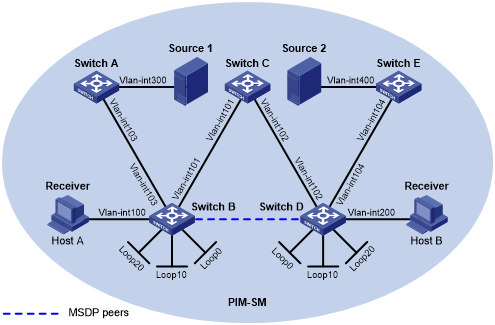Anycast RP configuration
Network requirements
As shown in Figure 40, OSPF runs within the domain to provide unicast routes.
Configure the Anycast RP application so that the receiver-side DRs and the source-side DRs can initiate a join process to their respective RPs that are topologically closest to them.
The router ID of Switch B is 1.1.1.1, and the router ID of Switch D is 2.2.2.2. Set up an MSDP peering relationship between Switch B and Switch D.
Figure 40: Network diagram
Table 11: Interface and IP address assignment
Device | Interface | IP address | Device | Interface | IP address |
|---|---|---|---|---|---|
Source 1 | — | 10.110.5.100/24 | Switch C | Vlan-int101 | 192.168.1.2/24 |
Source 2 | — | 10.110.6.100/24 | Switch C | Vlan-int102 | 192.168.2.2/24 |
Switch A | Vlan-int300 | 10.110.5.1/24 | Switch D | Vlan-int200 | 10.110.3.1/24 |
Switch A | Vlan-int103 | 10.110.2.2/24 | Switch D | Vlan-int104 | 10.110.4.1/24 |
Switch B | Vlan-int100 | 10.110.1.1/24 | Switch D | Vlan-int102 | 192.168.2.1/24 |
Switch B | Vlan-int103 | 10.110.2.1/24 | Switch D | Loop0 | 2.2.2.2/32 |
Switch B | Vlan-int101 | 192.168.1.1/24 | Switch D | Loop10 | 4.4.4.4/32 |
Switch B | Loop0 | 1.1.1.1/32 | Switch D | Loop20 | 10.1.1.1/32 |
Switch B | Loop10 | 3.3.3.3/32 | Switch E | Vlan-int400 | 10.110.6.1/24 |
Switch B | Loop20 | 10.1.1.1/32 | Switch E | Vlan-int104 | 10.110.4.2/24 |
Configuration procedure
Assign an IP address and subnet mask to each interface according to Figure 40. (Details not shown.)
Configure OSPF on the switches in the PIM-SM domain. (Details not shown.)
Enable IP multicast routing, IGMP, and PIM-SM:
# On Switch B, enable IP multicast routing.
<SwitchB> system-view [SwitchB] multicast routing [SwitchB-mrib] quit
# Enable IGMP on the receiver-side interface (VLAN-interface 100).
[SwitchB] interface vlan-interface 100 [SwitchB-Vlan-interface100] igmp enable [SwitchB-Vlan-interface100] quit
# Enable PIM-SM on the other interfaces.
[SwitchB] interface vlan-interface 103 [SwitchB-Vlan-interface103] pim sm [SwitchB-Vlan-interface103] quit [SwitchB] interface Vlan-interface 101 [SwitchB-Vlan-interface101] pim sm [SwitchB-Vlan-interface101] quit [SwitchB] interface loopback 0 [SwitchB-LoopBack0] pim sm [SwitchB-LoopBack0] quit [SwitchB] interface loopback 10 [SwitchB-LoopBack10] pim sm [SwitchB-LoopBack10] quit [SwitchB] interface loopback 20 [SwitchB-LoopBack20] pim sm [SwitchB-LoopBack20] quit
# Enable IP multicast routing, IGMP, and PIM-SM on Switch A, Switch C, Switch D, and Switch E in the same way Switch B is configured. (Details not shown.)
Configure C-BSRs and C-RPs:
# Configure Loopback 10 as a C-BSR and Loopback 20 as a C-RP on Switch B.
[SwitchB] pim [SwitchB-pim] c-bsr 3.3.3.3 [SwitchB-pim] c-rp 10.1.1.1 [SwitchB-pim] quit
# Configure a C-BSR and a C-RP on Switch D in the same way Switch B is configured. (Details not shown.)
Configure MSDP peers:
# Configure an MSDP peer on Loopback 0 of Switch B.
[SwitchB] msdp [SwitchB-msdp] originating-rp loopback 0 [SwitchB-msdp] peer 2.2.2.2 connect-interface loopback 0 [SwitchB-msdp] quit
# Configure an MSDP peer on Loopback 0 of Switch D.
[SwitchD] msdp [SwitchD-msdp] originating-rp loopback 0 [SwitchD-msdp] peer 1.1.1.1 connect-interface loopback 0 [SwitchD-msdp] quit
Verifying the configuration
Verify that the MSDP peer configurations are correct.
# Display brief information about MSDP peers on Switch B.
[SwitchB] display msdp brief Configured Established Listen Connect Shutdown Disabled 1 1 0 0 0 0 Peer address State Up/Down time AS SA count Reset count 2.2.2.2 Established 00:10:57 ? 0 0
# Display brief information about MSDP peers on Switch D.
[SwitchD] display msdp brief Configured Established Listen Connect Shutdown Disabled 1 1 0 0 0 0 Peer address State Up/Down time AS SA count Reset count 1.1.1.1 Established 00:10:57 ? 0 0
Verify that Switch B acts as the RP for Source 1 and Host A.
# Send an IGMP report from Host A to join multicast group 225.1.1.1. (Details not shown.)
# Send multicast data from Source 1 to the multicast group. (Details not shown.)
# Display the PIM routing table on Switch B.
[SwitchB] display pim routing-table Total 1 (*, G) entry; 1 (S, G) entry (*, 225.1.1.1) RP: 10.1.1.1 (local) Protocol: pim-sm, Flag: WC UpTime: 00:15:04 Upstream interface: Register Upstream neighbor: NULL RPF prime neighbor: NULL Downstream interface(s) information: Total number of downstreams: 1 1: Vlan-interface100 Protocol: igmp, UpTime: 00:15:04, Expires: - (10.110.5.100, 225.1.1.1) RP: 10.1.1.1 (local) Protocol: pim-sm, Flag: SPT 2MSDP ACT UpTime: 00:46:28 Upstream interface: Vlan-interface103 Upstream neighbor: 10.110.2.2 RPF prime neighbor: 10.110.2.2 Downstream interface(s) information: Total number of downstreams: 1 1: Vlan-interface100 Protocol: pim-sm, UpTime: - , Expires: -# Display the PIM routing table on Switch D.
[SwitchD] display pim routing-table
No information is output on Switch D.
Verify that Switch D acts as the RP for Source 2 and Host B.
# Send an IGMP leave message and an IGMP report to multicast group 225.1.1.1 from Host A and Host B, respectively. (Details not shown.)
# Send multicast data from Source 2 to the multicast group. (Details not shown.)
# Display the PIM routing table on Switch B.
[SwitchB] display pim routing-table
No information is output on Switch B.
# Display the PIM routing table on Switch D.
[SwitchD] display pim routing-table Total 1 (*, G) entry; 1 (S, G) entry (*, 225.1.1.1) RP: 10.1.1.1 (local) Protocol: pim-sm, Flag: WC UpTime: 00:12:07 Upstream interface: Register Upstream neighbor: NULL RPF prime neighbor: NULL Downstream interface(s) information: Total number of downstreams: 1 1: Vlan-interface200 Protocol: igmp, UpTime: 00:12:07, Expires: - (10.110.6.100, 225.1.1.1) RP: 10.1.1.1 (local) Protocol: pim-sm, Flag: SPT 2MSDP ACT UpTime: 00:40:22 Upstream interface: Vlan-interface104 Upstream neighbor: 10.110.4.2 RPF prime neighbor: 10.110.4.2 Downstream interface(s) information: Total number of downstreams: 1 1: Vlan-interface200 Protocol: pim-sm, UpTime: - , Expires: -
